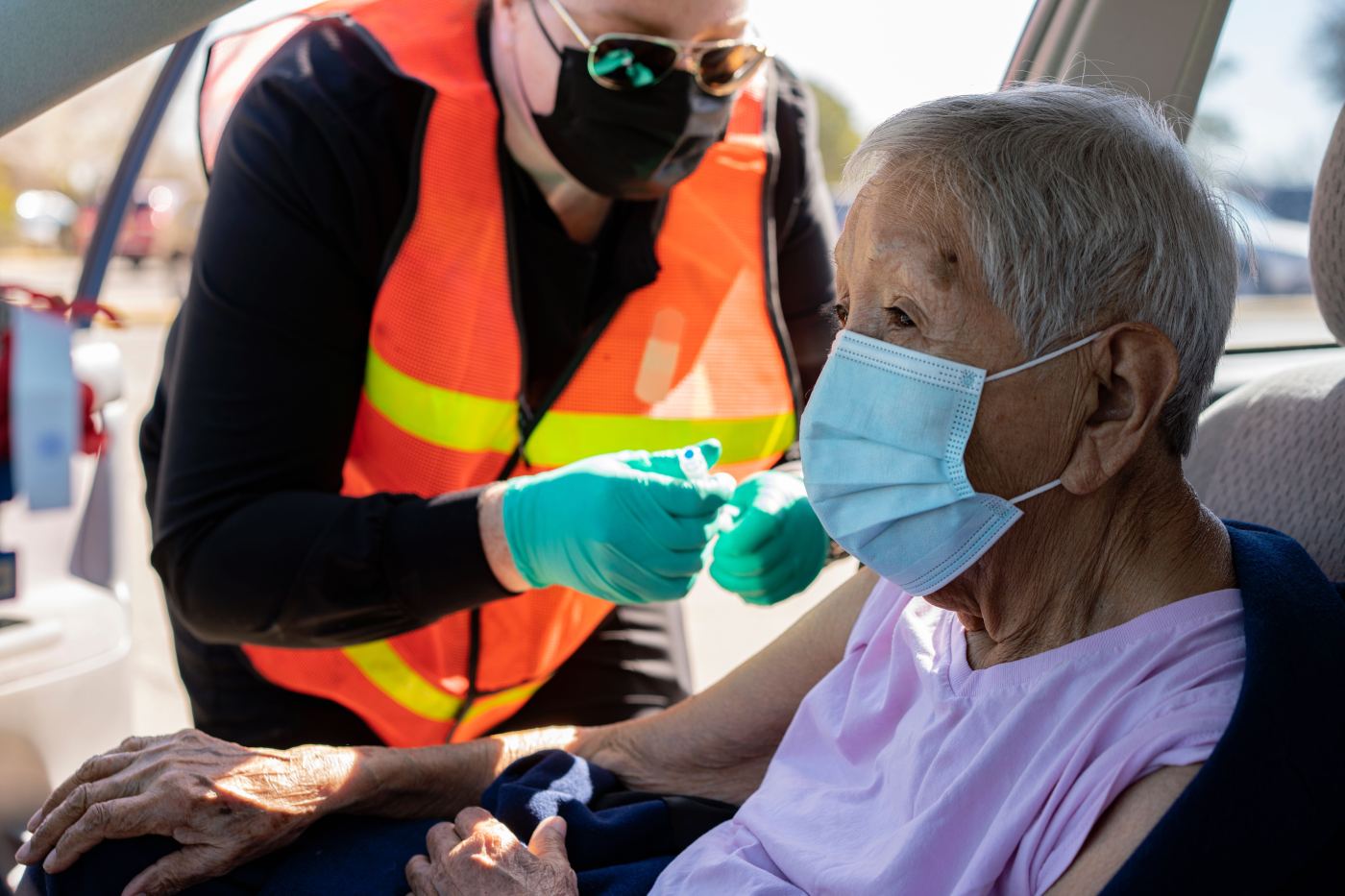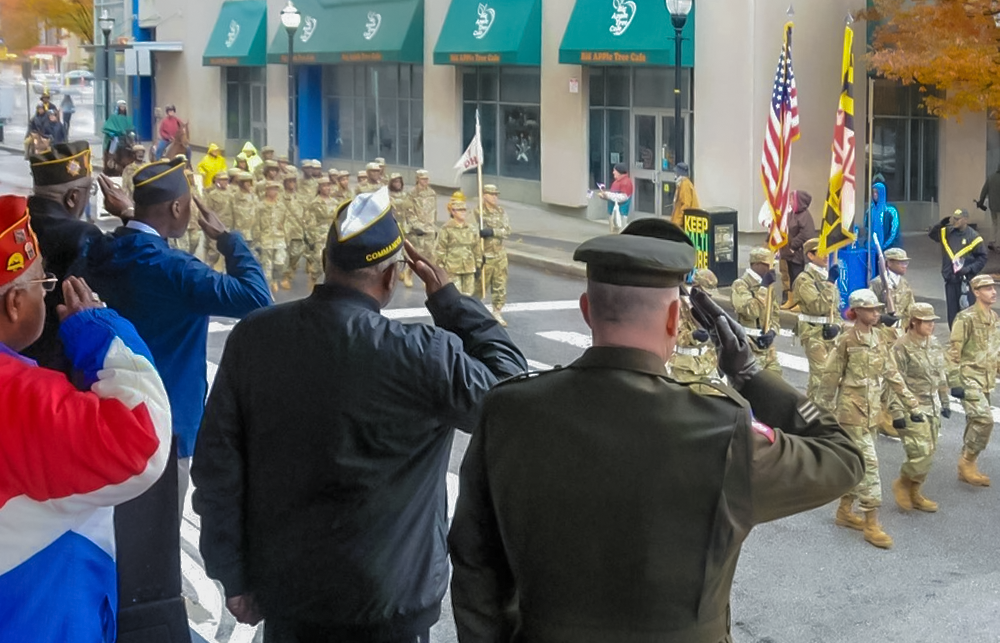As President Biden announced on May 11, the COVID-19 public health emergency is over. Since January 2021, COVID-19 deaths have declined by 95% and hospitalizations are down nearly 91%. Globally, COVID-19 deaths are at their lowest levels since the start of the pandemic. And while VA continues to care for Veterans with COVID-19 each and every day, it is important to take this time to reflect on how VA’s public servants responded to this national tragedy.
From the moment the pandemic hit, VA’s public servants mobilized around one core mission: provide world-class care and benefits to Veterans, their families, caregivers and survivors during this time of need. Throughout the pandemic, our public servants executed that mission by risking their own lives, sacrificing time with their families, sleeping overnight at hospitals and much more—all to save and improve the lives of Veterans.
As a result of these efforts, VA was able to provide more care and more benefits to more Veterans than ever before during the pandemic—including implementing the PACT Act, the biggest expansion of Veteran care and benefits in generations.
Here are some specific examples of outcomes for Veterans, their families, caregivers and survivors during the pandemic.
Health care
- Caring for Veterans with COVID-19: Between March 2020 and the end of the public health emergency, VA provided more than 332 million health care appointments to all Veterans via in-person visits, community care visits, telehealth visits, and more—the most appointments for such a time period in VA history. This included caring for more than 870,000 Veterans with COVID-19.
- Vaccinating Veterans, their families, caregivers, and survivors: VA fully vaccinated more than 4.4 million Veterans, 320,000 employees, and 130,000 Veteran caregivers, family members, and dependents. VA also gave booster shots to more than 2.3 million Veterans.
- Supporting the hardest hit areas of the country: VA’s public servants traveled across the country to support the areas hardest hit by COVID-19, providing care and vaccinations to Veterans and non-Veterans alike as a part of our “fourth mission” to help the nation respond to national emergencies. This included missions to nearly all 50 states and territories, as well as the Navajo Nation, Hopi Tribe and White Mountain Apache Tribe.
- Increasing telehealth flexibility: When the pandemic hit, VA dramatically increased telehealth appointments to provide Veterans with flexibility to see their health care providers from home. Specifically, Veteran telehealth appointments increased by more than 1800% from 41,500 in February 2020 to 807,800 in February 2023.
- Conducting groundbreaking research: VA’s researchers conducted more than 900 research projects (and counting) across more than 80 medical centers, ranging from therapeutic and vaccine clinical trials to observational studies. This included groundbreaking studies on the impact of Paxlovid on the risk for Long COVID, the risks of COVID-19 reinfection, suicidal ideation among Veterans during the pandemic, the effectiveness of booster shots, the effectiveness of COVID vaccines against variants, and much more. These studies helped VA understand COVID-19 and improve Veteran care.
- Providing life-saving personal protective equipment: To keep Veterans and clinicians safe, VA provided over 1 million pieces of personal protective equipment to State Veteran Homes and community hospitals, including gowns, gloves, masks and other equipment—such as ventilators, test kits and negative air machines.
- Leading the nation in understanding and treating Long COVID: VA has cared for Veterans with long COVID, conducted groundbreaking research on Long COVID, and created the nation’s first Whole Health System Approach to Long COVID guide—a guidebook that helps other hospitals understand and treat this disease.
- Fighting to end Veteran homelessness: In 2022 alone, VA housed more than 40,000 formerly homeless Veterans, providing them with the safe, stable homes that they deserve. VA also prevented more than 50,000 Veterans and their families from falling into homelessness, and VA helped nearly 530,000 additional Veteran families who were experiencing financial difficulties retain their homes or avoid foreclosure during the pandemic.
Earned benefits
- Delivering timely access to earned benefits: VA has delivered more benefits, and quicker, to more Veterans than ever before during the pandemic—processing record numbers of Veteran claims in 2020, 2021, 2022; and we are currently 15% ahead of that record pace in 2023. In 2022 alone, VA delivered $112 billion in earned benefits to Veterans with service-connected disabilities (from 1.7 million claims).
- Lowering the claims backlog: VA lowered the backlog of Veteran compensation claims by over 100,000 claims during fiscal year 2022. Additionally, since August 2022, the Veterans Benefits Administration has hired more than 3,400 employees to minimize the time that Veterans have to wait for their earned benefits. As a result, VA has increased the number of Veteran claims processed per day from around 6,000 per day pre-COVID to 7,000 per day during COVID; it’s now 8,000 per day.
- Providing educational and housing benefits to Veterans: VA implemented COVID-19 relief and provided more than $24 billion in housing and education payments to millions of Veterans and family members.
- Guaranteeing home loans for Veterans: VA guaranteed approximately 3.5 million home loans for Veterans and their families during the pandemic. VA home loans now account for 13% of all mortgages in the United States.
- Establishing tele-counseling for job training programs: VA’s Veteran Readiness and Employment program implemented tele-counseling, which enabled VA to help hundreds of thousands of Veterans during the public health emergency despite not being able to work with them in person.
- Expanding access to life insurance: VA established and opened enrollment for Veterans Affairs Life Insurance—the first new VA life insurance program for Veterans in more than 50 years—extending life insurance access to millions of Veterans. VALife provides up to $40,000 of whole life insurance for all Veterans, age 80 or under, with service-connected disabilities rated from 0-100%.
Memorial services
- Providing lasting resting places to our nation’s Veterans: VA kept national cemeteries open for burials and visitation throughout the pandemic, conducting record numbers of annual interments—nearly 150,000—in both 2021 and 2022. In total, VA conducted more than 450,000 interments during the pandemic, providing Veterans and family members with the lasting resting places that they deserve.
- Memorializing Veterans online: VA expanded the Veterans Legacy Memorial, allowing families, friends, and the public to memorialize Veterans online during a time when travel to cemeteries was challenging. As of today, roughly 4.8 million Veterans have tribute pages on VLM.
- Opening new cemeteries: VA opened 7 new national cemeteries serving over 500,000 Veterans, meaning that nearly 94% of Veterans now have access to a burial site within 75 miles of their homes.
- Improving the Veteran experience: Based on surveys of Veterans and their families, VA’s National Cemetery administration received the highest score ever recorded on the American Customer Satisfaction Index in 2022—a reflection of VA’s customer service at national cemeteries during the pandemic.
Topics in this story
More Stories
VA and the Veterans Day National Committee (VDNC) invites cities, towns, and non-profit groups across the country to join us in showing appreciation for Veterans by applying to hold VA-recognized regional Veterans Day observances.
VA and the Veterans Day National Committee are now accepting entries for the 2025 Veterans Day Poster Contest. Submissions are due by 11:59 p.m. (EDT) on May 2, 2025.
Secretary Doug Collins announces VA’s shift to in-person work, ensuring a smooth transition while prioritizing service to Veterans.






Hi I’m from the IRS or VA and I’m here to help… SAD
The VA claims process is broken especially as it relates to the BVA processing of Appeals under the H.R.2288, Veterans Appeals Improvement and Modernization Act of 2017, and the processing of a Veteran’s claims under “Direct Review by a Veterans Law Judge” option by the BVA, the average processing time of 365 days is currently more like 1,000 days. Even claims that are Remanded back to VA Regional offices where errors are identified. What is especially concerning about this issue is that the VA is aware of the problem and appears to doing nothing to correct it.
I completely agree with the article’s assessment of VA’s response to the COVID-19 pandemic. The dedication and sacrifices made by VA’s public servants are truly commendable. Their efforts in providing world-class care and benefits to Veterans, as well as their families, caregivers, and survivors, have been remarkable. The increased number of healthcare appointments, the successful vaccination campaigns, and the support provided to the hardest-hit areas demonstrate the effectiveness of VA’s response. Additionally, the expansion of telehealth services, groundbreaking research projects, provision of personal protective equipment, and the focus on understanding and treating Long COVID showcase VA’s comprehensive approach to addressing the challenges posed by the pandemic. The significant progress made in ending Veteran homelessness is also a testament to VA’s commitment to supporting those in need. Overall, VA’s response during this national tragedy has been exemplary, and they have positively impacted the lives of countless Veterans and their families.
No one wants to return to the office. There is no culture in the workforce, the culture is being able to be with your family!